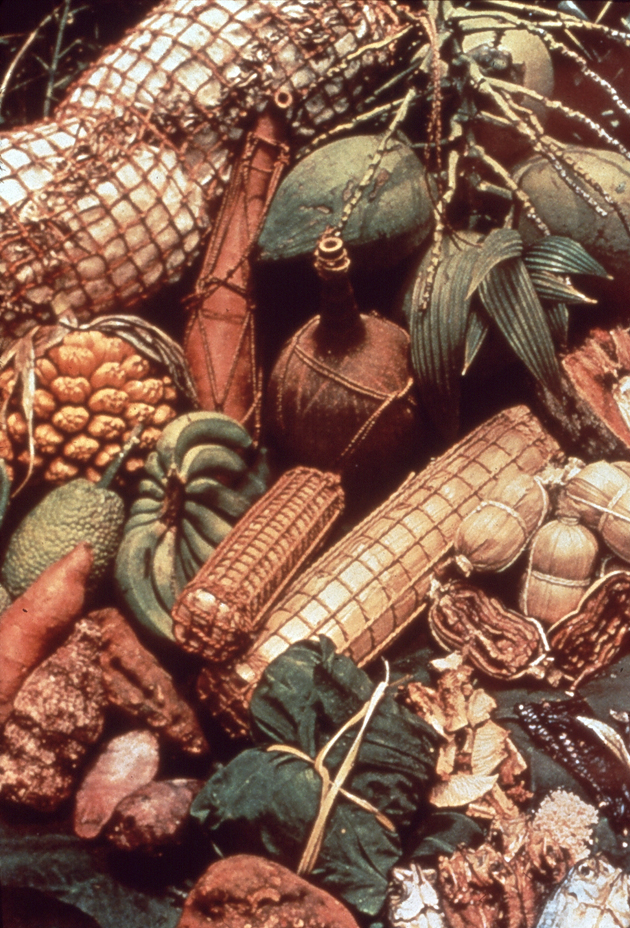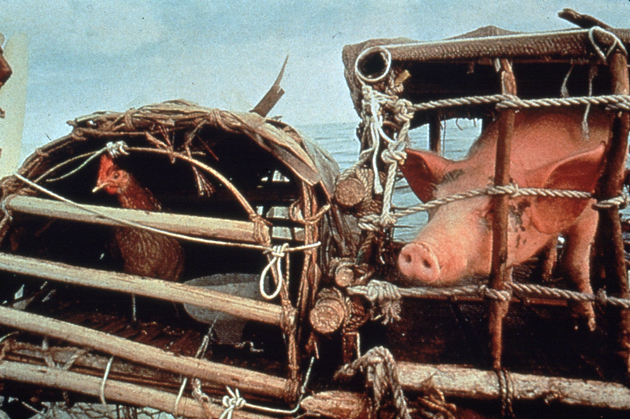Provisions for Polynesian Voyages
Tommy Holmes
[Tommy Holmes, researcher, writer, and waterman, was a co-founder of the Polynesian Voyaging Society. He was a crew member on Hokule'a's first voyage to Tahiti in 1976 and directed food, plant and animal experiments for the voyage. The following piece on provisioning is from "Voyaging," the second chapter of his classic book on canoes, The Hawaiian Canoe, published by Editions Unlimited in 1981.]
"Mr. Handy has seen ma [fermented breadfruit] a hundred years old, which is occasionally eaten at the present time."1 This was admittedly an unusually old batch (though still edible); the preferred aging time for fermented breadfruit in the Marquesas was about ten years. The Polynesians preserved most of the meals they would need for a long canoe voyage by drying or fermenting either raw or cooked food. Compact, light, nutritious and almost spoilage free, the voyagers' diet would have consisted of fish and other marine organisms, bananas, sweet potatoes, yams, breadfruit, taro, pandanus flour and other regional favorites. For the beginning of the voyage there would have been a number of fresh food items-sweet potatoes, yams, taro, breadfruit, drinking coconuts, bananas and sugar cane.2

Undoubtedly there were trolling lines out all day, every day. However, on some runs, as from eastern Polynesia to Hawai'i, there was a wide swath of relatively unproductive ocean, where marine life is scant. Thus in voyaging to Hawai'i one could not depend on catching many fish. The Hokule'a, which both times (1976 and 1980) took courses very probably similar to ones used many centuries ago, did catch some fish, though most of them within several hundred miles of an island group. Even under the most ideal conditions, it would have been nearly impossible to catch enough fish to sustain a canoe full of people and animals.
A hearth lined with stone, coral and sand and fueled by coconut husk and shell enabled the voyagers to cook at sea. Water was carried in gourds and sections of bamboo and stored along with drinking coconuts wherever space or ballast needs dictated. If a canoe encountered or could seek out a rain squall, water supplies could be supplemented by collecting water as it ran off the sail; if water was critically short people could temporarily subsist on the moisture found in the flesh of freshly caught fish, turtles, sharks and other marine organisms. Salt water could not effectively be used to stretch a dwindling water supply; it only hastens the dehydration process. Water rationing was undoubtedly practiced.
Floating zoos, Polynesian voyaging canoes carried pigs, chickens and dogs which were intended as breeding stock for a new settlement, though they could also be eaten if stores dipped perilously low. Rats were sometimes uninvited passengers and may have occasionally provided an emergency meal.

Experience had taught the Polynesian that very few edible plants grew on previously uninhabited islands, so with him he took a traveling garden. To Hawaiçi he brought about two dozen varieties of plants, though probably not all at the same time. Slips, cuttings, tubers and young plants were first swathed in fresh water-moistened moss, then swaddled in dry ti-leaf, kapa (bark cloth), or skin from the banana tree. Finally, these bundles were put in lauhala (pandanus leaf) casings and hung from the roof of the canoe's hut. Here they would best be protected from lethal salt water and salt spray. In a few cases, he took seeds.
On the first voyage of the Hokule'a down to Tahiti, an attempt was made to transport many of the same plants the Polynesians originally brought with them to Hawai‘i. Working with only fragments of the once sophisticated horticultural techniques the Polynesians employed to ensure viability, some plants died. However, most survived and were planted upon arrival in Tahiti. The dog, chickens and pig taken down on the Hokule'a adapted readily, arriving in Tahiti in excellent health.
Notes
1. Handy, E.S.C., Native Culture in the Marquesas. Honolulu: Bishop Museum, 1923, p. 188
2. Because of variations in geoclimatic conditions not all the foods mentioned were available at all island groups.
